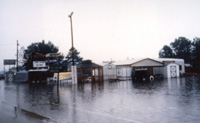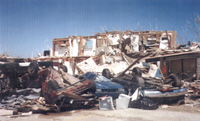Hurricane Floyd Disaster Investigation, North Carolina — 1999
 When Hurricane Floyd hit the state of North Carolina in 1999, flooding
soon followed. Health Studies Program (HSP) staff members were sent to
assess the environmental impact of the disaster.
When Hurricane Floyd hit the state of North Carolina in 1999, flooding
soon followed. Health Studies Program (HSP) staff members were sent to
assess the environmental impact of the disaster.
Earthquake Investigation, Turkey — 1999
On September 14, 1999, Conscience International, Inc., a U.S. nongovernmental, private, voluntary organization, and its partners at Istanbul University Department of Public Health and Marmara University Department of Public Health requested assistance from CDC to evaluate earthquake morbidity. The earthquake struck western Turkey on August 17, 1999. The groups also requested assistance in conducting a rapid epidemiologic assessment of the needs of displaced persons affected by the disaster.
Tornado Disaster Investigation, Oklahoma — 1999
 Several tornadoes hit the state in 1999, including one that struck
Oklahoma City. HSP staff were sent to Oklahoma City to determine where
individuals were located when the tornado struck and whether they had
heard any tornado warnings. HSP staff also investigated the health
effects of the tornado on individuals.
Several tornadoes hit the state in 1999, including one that struck
Oklahoma City. HSP staff were sent to Oklahoma City to determine where
individuals were located when the tornado struck and whether they had
heard any tornado warnings. HSP staff also investigated the health
effects of the tornado on individuals.
Hurricane Mitch Disaster Investigation, Honduras — November 1998
On October 30-31, 1998, Hurricane Mitch produced torrential rains, resulting in catastrophic flooding and landslides throughout Honduras. In southern municipalities, extensive flooding reportedly destroyed pesticide factories. On November 26-28, the International Medical Corps, in collaboration with the Honduran Secretaria de Salud and the Centro de Estudios y Control de Contaminantes, requested assistance from NCEH in conducting an environmental exposure assessment and in evaluating potential health effects related to chemical contamination of potable water and soil. HSP staff conducted an investigation in the barrio of Istoca in the department of Choluteca. HSP selected this community of approximately 3,100 residents in 440 households because it was severely hit by the hurricane and because 300-400 barrels of pesticides were known to have been released in the barrio. The investigation consisted of an environmental exposure assessment — including environmental and biological monitoring among 45 children aged 15 to 18 years — and a subjective questionnaire assessment of 155 households to identify potable water sources and potential health effects in Istoca.
HSP is working with the International Red Cross to provide post-disaster longitudinal follow-up of the changing needs among Latin American populations affected by Hurricane Mitch.
Tornado Disaster Investigation, Arkansas — March 1997
Severe weather including heavy rains and tornadoes swept through more than a dozen states over March 1-2, 1997. In Arkansas, an estimated nine tornadoes left an area of destruction spanning 260 miles from southwestern Hempstead County to northeastern Clay County. In collaboration with the Arkansas Department of Health, the CDC team described deaths, injuries, and illnesses related to tornadoes as environmental disasters and conducted a population-based cross-sectional study to assess the effectiveness of warning systems and behavioral reactions during the tornado; and assessed the availability of appropriate resources for disaster relief. Results will be used to provide public health recommendations to prevent or reduce mortality and morbidity in future tornado events and to determine effective strategies for disaster response.
Forest Fire Investigation, Malaysia — February 1997
In 1997, uncontrolled forest fires in Indonesia resulted in severe smoke pollution in seven countries throughout Southeast Asia. Peak episodes occurred in September 1997 and again in March-April 1998 when ambient concentrations of fine particulate matter increased more than tenfold. During those same periods, respiratory-related hospital admissions increased significantly. Principal findings of studies that the World Health Organization compiled indicated that the haze episodes presented a substantial health risk to the public. In Malaysia, haze concentration levels exceeded ambient air quality standards and guidelines for particulate matter in most exposed areas of the country.
In February 1997, the Ministry of Science and Technology of Malaysia requested the U.S. government's assistance in assessing short- and long-term public health impacts of haze. HSB and the Air Pollution and Respiratory Health Branch of the Centers for Disease Control and Prevention's (CDC) National Center for Environmental Health were given the assignment. In collaboration with the Ministry of Health, the team evaluated the feasibility of conducting 1) an environmental exposure assessment, 2) a study of children < 12 years of age and selected health outcomes related to the constituents of haze, and 3) a study of maternal exposure to haze during pregnancy and birth outcomes.
Flood Response, Nevada — January 1997
In early January 1997, severe winter storms resulted in extensive flooding and mudslides throughout the northwestern United States. The State of Nevada requested an investigation of human exposures to sewage-contaminated flood water and to potential chemicals in the water, including volatile organic compounds, pesticides, and heavy metals. In collaboration with the state, the CDC team evaluated possible effects that flooding may have on private wells and assessed flood-related morbidity in households served by these wells. Results will be used to formulate recommendations for responding to flood emergencies and to provide guidelines for water quality in privately owned wells, particularly after flooding.
Hurricane Fran Health Impact Surveillance, North Carolina — September 1996
In an effort to better record the health effects of disasters, the American Red Cross (ARC) and CDC established in 1987 the Health Impact Surveillance System for Disasters under a Memorandum of Agreement. After a formative evaluation of the surveillance system in 1995, CDC proposed modifications for improving the system. In 1996, CDC evaluated the ARC-CDC surveillance system in a field setting by observing the collection of data on disaster-related morbidity and mortality in a disaster-stricken community and among Red Cross field personnel.
We traced the flow of health information from the surveillance system after Hurricane Fran struck the coast of North Carolina and moved inland in September 1996. We interviewed ARC health services personnel from the field emergency operations center, from service centers in selected disaster sites, and from shelters along the coastline. We outlined the flow of information that these personnel sent from the field to the Federal Emergency Management Agency's Disaster Field Office, to the ARC national headquarters, and ultimately, to CDC.
We found that the data were useful and representative of the affected population's mortality and morbidity. The surveillance system has low operating costs and is highly accepted by emergency managers and ARC officials. We demonstrated that the surveillance system — with proposed modifications suggested by results from another ARC-CDC survey of state emergency managers, state emergency response coordinators, and public health officials conducted in February 1996 — can indeed provide information that will help emergency officials prepare to respond to the health and socioeconomic effects of disasters such as hurricanes.



